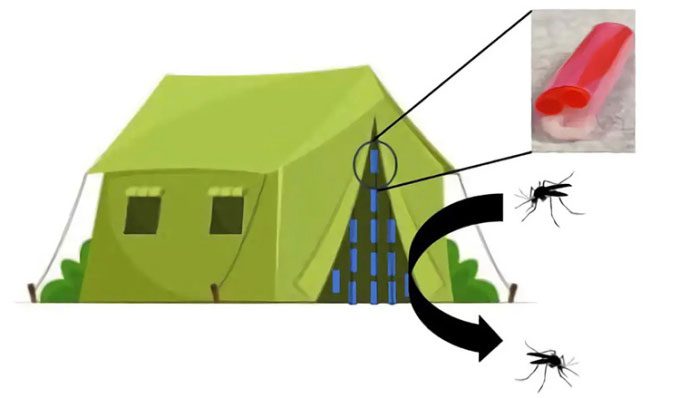University of Florida Develops Compact, Controlled Passive Insecticide Device Successfully Tested Against Mosquitoes for Four Weeks.
Scientists have developed a device capable of repelling mosquitoes for an extended period without the need for heat, electricity, or skin contact, SciTechDaily reported on January 28. The new device was designed by researcher Nagarajan Rajagopal and Dr. Christopher Batich from the Department of Materials Science and Engineering at the University of Florida, funded by the U.S. Department of Defense’s Soldier Protection Program.

Illustration of using the controlled passive insecticide device for military tents to combat mosquitoes. (Photo: University of Florida)
The device was successfully tested in a four-week semi-field study in Gainesville in collaboration with Dr. Daniel Kline, Dr. Jerry Hogsette, and Adam Bowman from the USDA’s Veterinary Medicine, Agriculture, and Entomology Center.
Results showed that the controlled release of transfluthrin was effective in preventing numerous mosquito species from entering the testing site. Transfluthrin is an organic insecticide considered safe for humans and animals.
“Our device eliminates the need for site-specific insect repellents or spraying in open areas, which can contaminate surrounding vegetation or water and adversely affect beneficial pollinators like bees and butterflies. The new device is highly flexible, portable, easy to deploy, and does not require electricity or heat to activate,” Rajagopal stated.
The controlled passive insecticide device is made of 2.5 cm long polypropylene tubing, consisting of two smaller tubes filled with insect repellent cotton. The research team attached 70 devices at the entrance of a large military tent using fishing line. They also monitored a similar tent without the devices. Rajagopal noted that mosquitoes released at various points outside the tent were mostly killed or repelled within 24 hours.
The testing demonstrated that the prototype device created a mosquito-free space for four weeks. However, the final product will be manufactured using 3D printing technology, extending this period to three months.
The research team is applying for a patent for the new device. The U.S. government is also interested in further research to potentially commercialize the device for the civilian market. USDA scientists believe that outdoor enthusiasts, such as hikers or fishermen, could benefit from it. The research team will also evaluate other substances beyond transfluthrin to expand the device’s potential, not only against mosquitoes but also against other insects, such as ticks.


















































